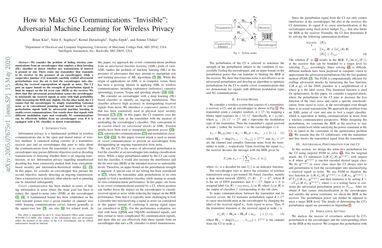How to Make 5G Communications "Invisible": Adversarial Machine Learning for Wireless Privacy
We consider the problem of hiding wireless communications from an eavesdropper that employs a deep learning (DL) classifier to detect whether any transmission of interest is present or not. There exists one transmitter that transmits to its receiver in the presence of an eavesdropper, while a cooperative jammer (CJ) transmits carefully crafted adversarial perturbations over the air to fool the eavesdropper into classifying the received superposition of signals as noise. The CJ puts an upper bound on the strength of perturbation signal to limit its impact on the bit error rate (BER) at the receiver. We show that this adversarial perturbation causes the eavesdropper to misclassify the received signals as noise with high probability while increasing the BER only slightly. On the other hand, the CJ cannot fool the eavesdropper by simply transmitting Gaussian noise as in conventional jamming and instead needs to craft perturbation signals built by adversarial machine learning to enable covert communications. Our results show that signals with different modulation types and eventually 5G communications can be effectively hidden from an eavesdropper even if it is equipped with a DL classifier to detect transmissions.
PDF Abstract
